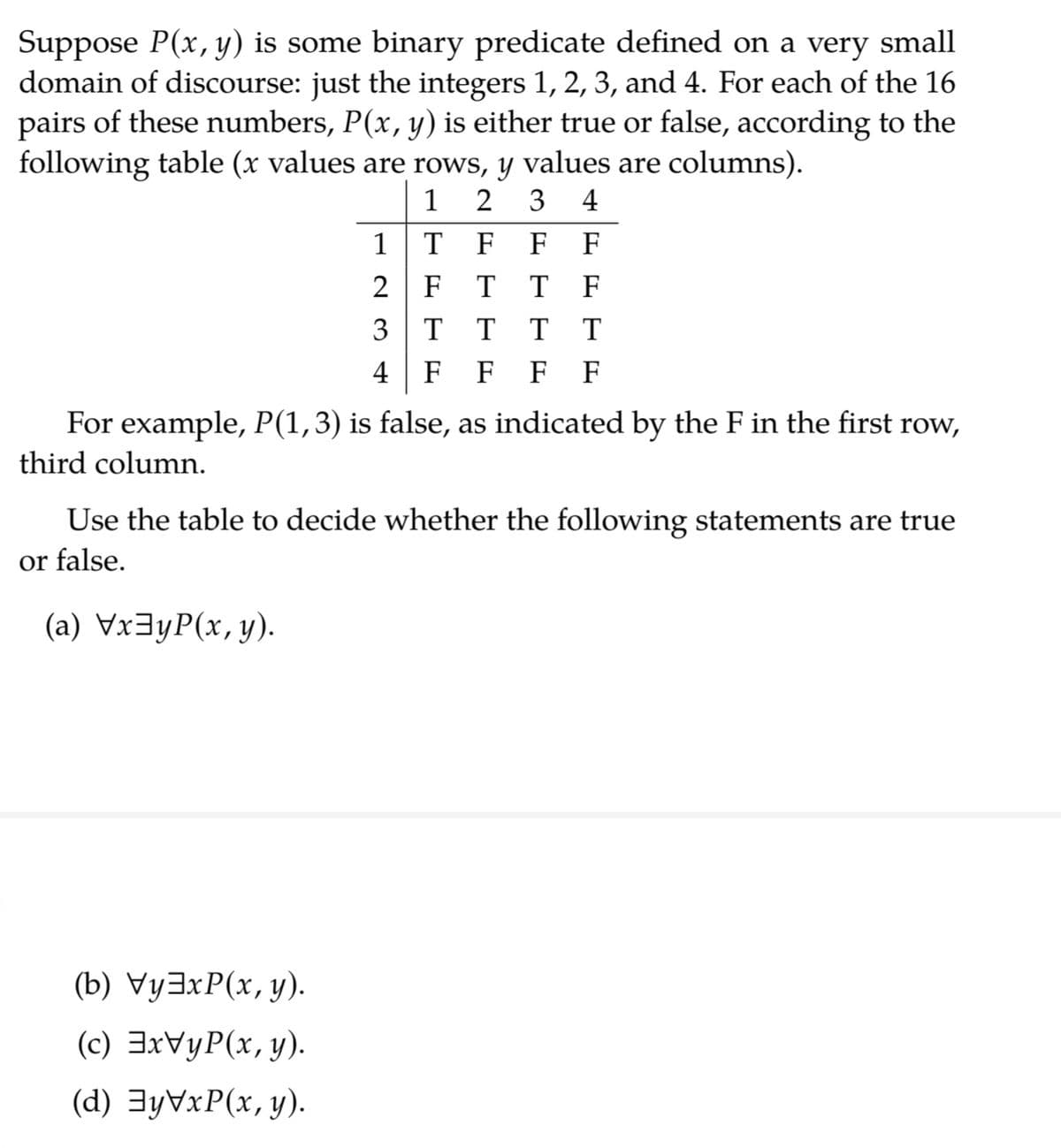Suppose P(x, y) is some binary predicate defined on a very small domain of discourse: just the integers 1, 2, 3, and 4. For each of the 16 pairs of these numbers, P(x, y) is either true or false, according to the following table (x values are rows, y values are columns). 1 2 3 4 1 T F F F T F 2 F T 3 тт тт 4 F F F F For example, P(1,3) is false, as indicated by the F in the first row, third column. Use the table to decide whether the following statements are true or false. (a) Vx3yP(x, y).
Suppose P(x, y) is some binary predicate defined on a very small domain of discourse: just the integers 1, 2, 3, and 4. For each of the 16 pairs of these numbers, P(x, y) is either true or false, according to the following table (x values are rows, y values are columns). 1 2 3 4 1 T F F F T F 2 F T 3 тт тт 4 F F F F For example, P(1,3) is false, as indicated by the F in the first row, third column. Use the table to decide whether the following statements are true or false. (a) Vx3yP(x, y).
Database System Concepts
7th Edition
ISBN:9780078022159
Author:Abraham Silberschatz Professor, Henry F. Korth, S. Sudarshan
Publisher:Abraham Silberschatz Professor, Henry F. Korth, S. Sudarshan
Chapter1: Introduction
Section: Chapter Questions
Problem 1PE
Related questions
Question
100%
Stuck need help!
The class I'm taking is computer science discrete structures.
Problem is attached.
please view before answering.
Please explain answer so I can fully understand.
Thank you so much!

Transcribed Image Text:Suppose P(x, y) is some binary predicate defined on a very small
domain of discourse: just the integers 1, 2, 3, and 4. For each of the 16
pairs of these numbers, P(x, y) is either true or false, according to the
following table (x values are rows, y values are columns).
1
2
3
4
1
T
F
F
F
2
F
тт
F
3
T
T
T
4
F F F F
For example, P(1,3) is false, as indicated by the F in the first row,
third column.
Use the table to decide whether the following statements are true
or false.
(a) Vx3yP(x, y).
(b) Wy3xP(х, у).
(c) 3xVyP(x, y).
(d) 3yVxP(x, y).
Expert Solution
This question has been solved!
Explore an expertly crafted, step-by-step solution for a thorough understanding of key concepts.
This is a popular solution!
Trending now
This is a popular solution!
Step by step
Solved in 2 steps with 2 images

Recommended textbooks for you

Database System Concepts
Computer Science
ISBN:
9780078022159
Author:
Abraham Silberschatz Professor, Henry F. Korth, S. Sudarshan
Publisher:
McGraw-Hill Education

Starting Out with Python (4th Edition)
Computer Science
ISBN:
9780134444321
Author:
Tony Gaddis
Publisher:
PEARSON

Digital Fundamentals (11th Edition)
Computer Science
ISBN:
9780132737968
Author:
Thomas L. Floyd
Publisher:
PEARSON

Database System Concepts
Computer Science
ISBN:
9780078022159
Author:
Abraham Silberschatz Professor, Henry F. Korth, S. Sudarshan
Publisher:
McGraw-Hill Education

Starting Out with Python (4th Edition)
Computer Science
ISBN:
9780134444321
Author:
Tony Gaddis
Publisher:
PEARSON

Digital Fundamentals (11th Edition)
Computer Science
ISBN:
9780132737968
Author:
Thomas L. Floyd
Publisher:
PEARSON

C How to Program (8th Edition)
Computer Science
ISBN:
9780133976892
Author:
Paul J. Deitel, Harvey Deitel
Publisher:
PEARSON

Database Systems: Design, Implementation, & Manag…
Computer Science
ISBN:
9781337627900
Author:
Carlos Coronel, Steven Morris
Publisher:
Cengage Learning

Programmable Logic Controllers
Computer Science
ISBN:
9780073373843
Author:
Frank D. Petruzella
Publisher:
McGraw-Hill Education